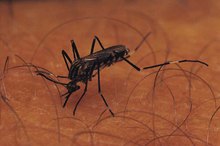What does fact checked mean?
At Healthfully, we strive to deliver objective content that is accurate and up-to-date. Our team periodically reviews articles in order to ensure content quality. The sources cited below consist of evidence from peer-reviewed journals, prominent medical organizations, academic associations, and government data.
- MayoClinic.com: Symptoms of Hepatitis A
- FamilyDoctor.org: How Does Giardiasis Spread At Day Care Centers?
The information contained on this site is for informational purposes only, and should not be used as a substitute for the advice of a professional health care provider. Please check with the appropriate physician regarding health questions and concerns. Although we strive to deliver accurate and up-to-date information, no guarantee to that effect is made.
Diseases You Can Get From Not Washing Your Hands After Bathroom Use
Bacterial, viral, fungal and parasitic diseases exist on the skin and in mucus, blood and other body fluids. Some germs are transferred through inhalation and others are obtained by touch. The transfer of fecal-to-oral diseases occurs when an infected person does not use good hand-washing technique with soap and water and handles food content or any substance that enters the mouth. Washing hands after bathroom use can significantly reduce transmission of diseases and illness.
If you are experiencing serious medical symptoms, seek emergency treatment immediately.
Hand-Foot-Mouth Disease
The virus spreads by ingesting food or drink contaminated with fecal content. Thorough washing of the hands following bathroom use is vital in preventing the spread of hand-foot-mouth disease. Since antibiotics are ineffective against viruses, treatment consists of comfort measures for fever and blisters.
Hepatitis A
Diseases Caused by Drinking Water From the Bird Bath
Learn More
Hepatitis A, a highly contagious viral liver infection, manifests with symptoms such as:
- fatigue
- yellowing of the skin
- dark urine
- nausea
- vomiting 1
MayoClinic.com reports that symptoms usually don't appear until a month after incurring the virus, and the symptoms last from less than two to six months 1. Some people with hepatitis A never show any signs of the disease.
Shigellosis
Shigellosis is a bacterial infection with symptoms that include watery diarrhea, abdominal cramps and fever. If the disease progresses to dysentery, the stool contains mucus, blood and pus. Shigellosis spreads easily from one person to another by ingesting food contaminated by infected people who do not use adequate hand-washing technique with soap and water after using the bathroom.
The Merck Manuals Online Medical Library states that symptoms usually resolve within four to eight days. Treatment with antibiotics such as azithromycin or ciprofloxacin is prescribed, if the infection is severe.
- Shigellosis is a bacterial infection with symptoms that include watery diarrhea, abdominal cramps and fever.
- Shigellosis spreads easily from one person to another by ingesting food contaminated by infected people who do not use adequate hand-washing technique with soap and water after using the bathroom.
Giardiasis
How to Disinfect Herpes or Shingles Virus
Learn More
Giardiasis is a parasitic illness of the intestine with symptoms such as gas, cramping and diarrhea. Giardiasis spreads easily by drinking infected water from untreated sources or by hand-to-fecal contact. FamilyDoctor.org reports that workers in daycare centers should use thorough hand-washing techniques after diaper changes to help prevent the spread of giardiasis from one child to another 2.
Diagnosis requires examination of stool samples under a microscope. Treatment usually consists of metronidazole for five to 10 days. For children younger than 5, furazolidone may be the treatment of choice. The doctor may request a repeat sample to confirm the disease is totally gone.
- Giardiasis is a parasitic illness of the intestine with symptoms such as gas, cramping and diarrhea.
- FamilyDoctor.org reports that workers in daycare centers should use thorough hand-washing techniques after diaper changes to help prevent the spread of giardiasis from one child to another 2.
Related Articles
References
Writer Bio
Norene Anderson has been a writer since 2003. She is also a registered nurse with expertise in a wide range of medical conditions and treatments. Anderson received her associate degree in nursing from Lincoln University in Jefferson City, Mo.









